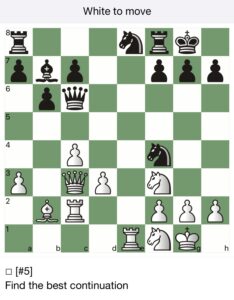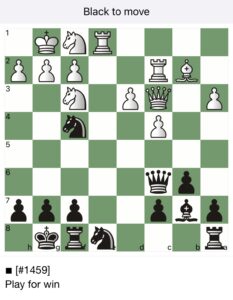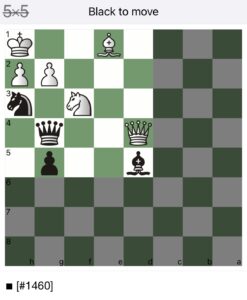Goal: To enhance my middle-to-end game with challenging puzzles
Source: CT-ART 4.0 ★★★★☆
What I Learned
Over the past few sessions, I dedicated time to the first section of the “Learning” tab in CT-ART 4.0: Annihilation of Defence. The puzzles in this section challenged my understanding of tactics, particularly around piece exchanges and the art of sacrifices.
One of the key takeaways was the importance of move order. I realized that, with careful sequencing, I could often capture an extra piece by simply forcing the right exchanges. It taught me that chess isn’t always about grabbing material as quickly as possible, but rather about setting traps and baiting the opponent into weakening their own defences.
I also learned to reevaluate how I view sacrifices. Instead of fearing the loss of a valuable piece, I began to see how sacrificing a stronger piece can sometimes dismantle an opponent’s defensive structure, especially when their less valuable pieces are key defenders. Often, this made room for forks, which I hadn’t been spotting consistently before. It became clear that starting sacrifices with my least threatening piece gave my stronger attackers more influence later in the sequence.
These puzzles helped me upgrade my eye for middle game tactics and taught me to think multiple moves ahead, not just in terms of material, but in the bigger picture of board control and forcing sequences.
Did I Find Success?
Yes, overall, the project felt successful. One of the major strengths of CT-ART 4.0 is its structure: it completely skips the opening phase, which lets me focus entirely on the middle and endgame (exactly where I was trying to improve). Since there was no time pressure, I could slow down and analyze each board in depth, something I rarely get to do during timed online games.
The puzzles were clearly designed to drill specific tactical patterns. That kind of focused practice felt much more effective than trying to learn those ideas in the middle of a live game. Even when I knew what to do right away, I still found myself double-checking my moves, often taking five minutes just to confirm a decision. That process, while slow, trained me to be more thorough in my play.
By taking my time and working through failure without frustration, I was able to absorb patterns that I hope will come more naturally in real-time games. I genuinely believe that if I continued this kind of focused training daily, I’d see a significant leap in my game strength.
What It Was Like Learning From the Source
CT-ART 4.0 is a mixed bag when it comes to the learning experience. On one hand, it delivers sharp, targeted training. On the other hand, it can be rigid and occasionally frustrating.
Every puzzle had one right answer. While this gave the platform clarity and focus, it also left little room for exploring alternate solutions. If you made two failed attempts, you’d be redirected to a simplified mini-puzzle to reinforce the tactical theme. After multiple failures, the app would even move the correct piece for you (something I personally didn’t appreciate). It took away the opportunity to struggle and find the move or make mistakes myself.
That said, this strict structure kept me from guessing randomly. I felt compelled to slow down and engage deeply with each position. Even when I was confident, I often paused to second-guess and fully analyze my plan before moving. In that sense, the app taught me patience and thoroughness.
I appreciated the feature that allowed me to replay puzzles from the opposite perspective, solving them from Black’s side. It offered variety and helped cement the ideas. Some puzzles included alternative responses from the opponent, which forced me to adapt my plan.
If I had to critique anything, it would be the app’s outdated interface. The design feels old and uninspiring, but for the quality of the content, I’m willing to overlook that.
Final Thoughts:
CT-ART 4.0 provided a deep, focused way to improve my middle to end game. It taught me new tactics, refined my thought process, and made me a more deliberate player. With consistent daily practice, I believe the improvements will only multiply.



